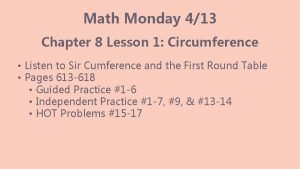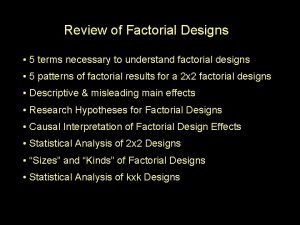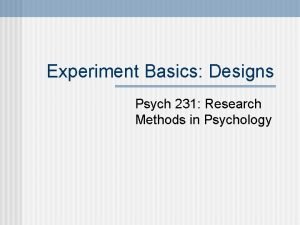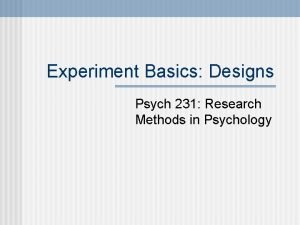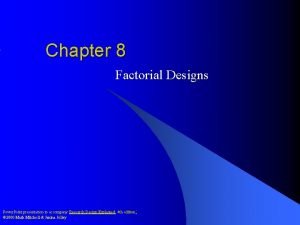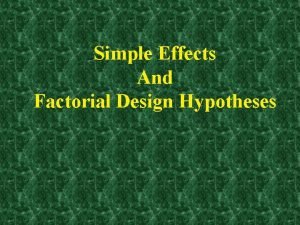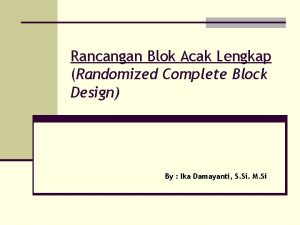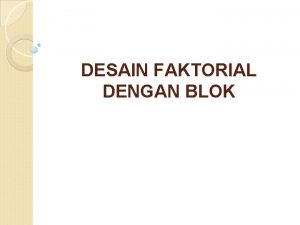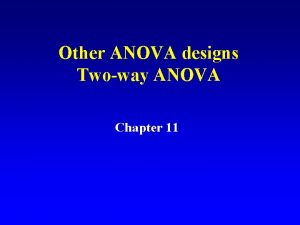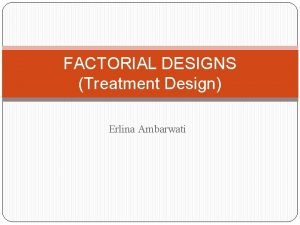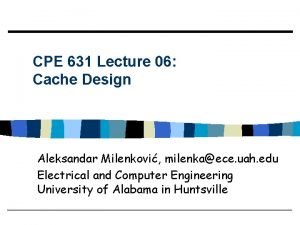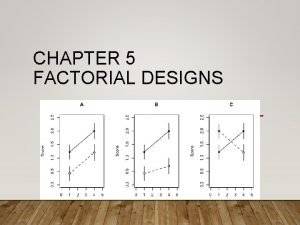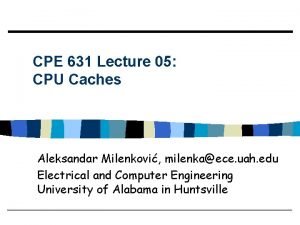CPE 619 2 kp Factorial Design Aleksandar Milenkovi

































- Slides: 33

CPE 619 2 k-p Factorial Design Aleksandar Milenković The La. CASA Laboratory Electrical and Computer Engineering Department The University of Alabama in Huntsville http: //www. ece. uah. edu/~milenka http: //www. ece. uah. edu/~lacasa

PART IV: Experimental Design and Analysis How to: n Design a proper set of experiments for measurement or simulation n Develop a model that best describes the data obtained n Estimate the contribution of each alternative to the performance n Isolate the measurement errors n Estimate confidence intervals for model parameters n Check if the alternatives are significantly different n Check if the model is adequate 2

Introduction n n n 2 k-p Fractional Factorial Designs Sign Table for a 2 k-p Design Confounding Other Fractional Factorial Designs Algebra of Confounding Design Resolution 3

2 k-p Fractional Factorial Designs n n Large number of factors ) large number of experiments ) full factorial design too expensive ) Use a fractional factorial design 2 k-p design allows analyzing k factors with only 2 k-p experiments n n 2 k-1 design requires only half as many experiments 2 k-2 design requires only one quarter of the experiments 4

Example: 27 -4 Design n Study 7 factors with only 8 experiments! 5

Fractional Design Features n Full factorial design is easy to analyze due to orthogonality of sign vectors n n Fractional factorial designs also use orthogonal vectors That is The sum of each column is zero åi xij =0 8 j jth variable, ith experiment n The sum of the products of any two columns is zero åi xijxil=0 8 j¹ l n The sum of the squares of each column is 27 -4, that is, 8 åi xij 2 = 8 8 j 6

Analysis of Fractional Factorial Designs n Model: n Effects can be computed using inner products 7

Example 19. 1 n Factors A through G explain 37. 26%, 4. 74%, 43. 40%, 6. 75%, 0%, 8. 06%, and 0. 03% of variation, respectively Use only factors C and A for further experimentation 8

Sign Table for a 2 k-p Design Steps: 1. Prepare a sign table for a full factorial design with k-p factors 2. Mark the first column I 3. Mark the next k-p columns with the k-p factors 4. Of the (2 k-p-1) columns on the right, choose p columns and mark them with the p factors which were not chosen in step 1 9

Example: 27 -4 Design 10

Example: 24 -1 Design 11

Confounding n Confounding: Only the combined influence of two or more effects can be computed. 12

Confounding (cont’d) n ) Effects of D and ABC are confounded. Not a problem if q. ABC is negligible. 13

Confounding (cont’d) n n Confounding representation: D=ABC Other Confoundings: I=ABCD ) confounding of ABCD with the mean 14

Other Fractional Factorial Designs n A fractional factorial design is not unique. 2 p different designs n Confoundings: Not as good as the previous design 15

Algebra of Confounding n n Given just one confounding, it is possible to list all other confoundings Rules: n n I is treated as unity. Any term with a power of 2 is erased. Multiplying both sides by A: 16

Algebra of Confounding (cont’d) Multiplying both sides by B, C, D, and AB: and so on. n Generator polynomial: I=ABCD For the second design: I=ABC. n In a 2 k-p design, 2 p effects are confounded together 17

Example 19. 7 n In the 27 -4 design: n Using products of all subsets: 18

Example 19. 7 (cont’d) n Other confoundings: 19

Design Resolution n n Order of an effect = Number of terms Order of ABCD = 4, order of I = 0. Order of a confounding = Sum of order of two terms E. g. , AB=CDE is of order 5. Resolution of a Design = Minimum of orders of confoundings Notation: RIII = Resolution-III = 2 k-p. III Example 1: I=ABCD RIV = Resolution-IV = 24 -1 IV 20

Design Resolution (cont’d) n n Example 2: I = ABD RIII design. Example 3: This is a resolution-III design A design of higher resolution is considered a better design 21

Case Study 19. 1: Latex vs. troff 22

Case Study 19. 1 (cont’d) n Design: 26 -1 with I=BCDEF 23

Case Study 19. 1: Conclusions n n n Over 90% of the variation is due to: Bytes, Program, and Equations and a second order interaction Text file size were significantly different making it's effect more than that of the programs High percentage of variation explained by the ``program £ Equation'' interaction Choice of the text formatting program depends upon the number of equations in the text. troff not as good for equations 24

Case Study 19. 1: Conclusions (cont’d) n n Low ``Program £ Bytes'' interaction ) Changing the file size affects both programs in a similar manner. In next phase, reduce range of file sizes. Alternately, increase the number of levels of file sizes. 25

Case Study 19. 2: Scheduler Design n n Three classes of jobs: word processing, data processing, and background data processing. Design: 25 -1 with I=ABCDE 26

Measured Throughputs 27

Effects and Variation Explained 28

Case Study 19. 2: Conclusions n n n n n For word processing throughput (TW): A (Preemption), B (Time slice), and AB are important. For interactive jobs: E (Fairness), A (preemption), BE, and B (time slice). For background jobs: A (Preemption), AB, B (Time slice), E (Fairness). May use different policies for different classes of workloads. Factor C (queue assignment) or any of its interaction do not have any significant impact on the throughput. Factor D (Requiring) is not effective. Preemption (A) impacts all workloads significantly. Time slice (B) impacts less than preemption. Fairness (E) is important for interactive jobs and slightly important for background jobs. 29

Summary n n Fractional factorial designs allow a large number of variables to be analyzed with a small number of experiments Many effects and interactions are confounded The resolution of a design is the sum of the order of confounded effects A design with higher resolution is considered better 30

Exercise 19. 1 Analyze the 24 -1 design: n n n Quantify all main effects Quantify percentages of variation explained Sort the variables in the order of decreasing importance List all confoundings Can you propose a better design with the same number of experiments What is the resolution of the design? 31

Exercise 19. 2 Is it possible to have a 24 -1 III design? a 24 -1 II design? 241 design? If yes, give an example. IV 32

Homework n n n n Updated Exercise 19. 1 Analyze the 24 -1 design: Quantify all main effects. Quantify percentages of variation explained. Sort the variables in the order of decreasing importance. List all confoundings. Can you propose a better design with the same number of experiments. What is the resolution of the design? 33
 Milenkovi
Milenkovi Milenkovi
Milenkovi Milenkovi
Milenkovi Milenkovi
Milenkovi Milenkovi
Milenkovi Milenkovi
Milenkovi Requisitos de los títulos valores
Requisitos de los títulos valores Xkcd
Xkcd Xkcd correlation
Xkcd correlation Swe 619 gmu
Swe 619 gmu Lesson 2 extra practice area of circles answer key
Lesson 2 extra practice area of circles answer key Swe 619
Swe 619 Swe 619
Swe 619 Swe 619 gmu
Swe 619 gmu Sf 619
Sf 619 Idea part b section 619
Idea part b section 619 619 rounded to the nearest ten
619 rounded to the nearest ten 2x2 between subjects factorial design
2x2 between subjects factorial design 2x2 factorial design
2x2 factorial design Between subjects design
Between subjects design Factorial designs
Factorial designs Within subjects design
Within subjects design Between subjects design vs within
Between subjects design vs within Design of experiments six sigma
Design of experiments six sigma Rancangan faktorial
Rancangan faktorial Factorial design ppt
Factorial design ppt Three way factorial design
Three way factorial design Simple effect in factorial design
Simple effect in factorial design Rbal
Rbal Factorial randomized block design
Factorial randomized block design Jmp doe analysis
Jmp doe analysis Advantages of factorial design slideshare
Advantages of factorial design slideshare Anova table
Anova table Contoh factorial design
Contoh factorial design










